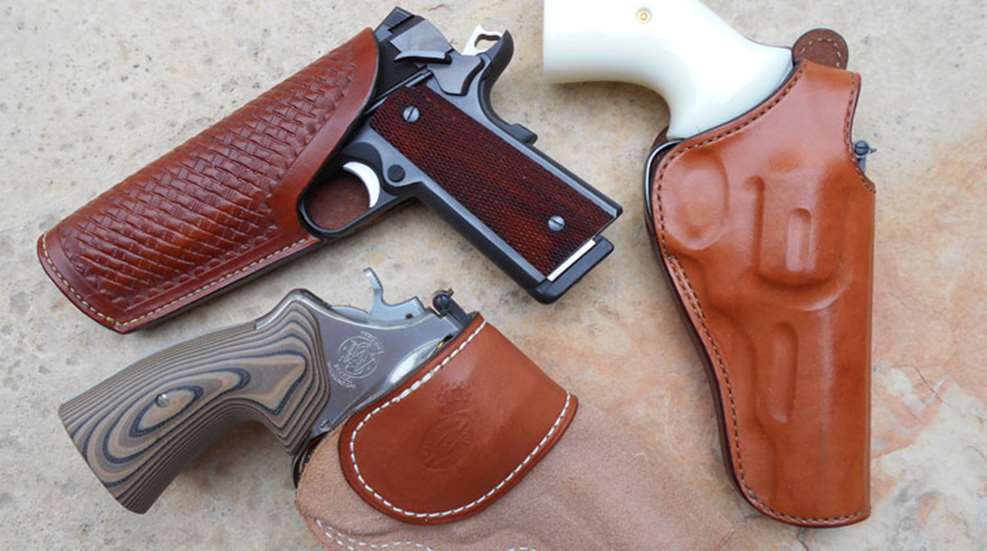Choosing the right holster for your firearm is a crucial decision for anyone who carries a gun, whether for professional use, self-defense, or sport. A proper holster not only secures your firearm but also ensures comfort, accessibility, and safety. Here, we’ll discuss the key factors to consider when selecting a holster that meets your needs and preferences.
Understanding Holster Types
Before diving into specific considerations, it’s essential to understand the different types of holsters available:
- Inside-the-Waistband (IWB) Holsters: Worn inside the pants, IWB holsters offer concealment and easy access. They are ideal for discreet carry but may require looser clothing for comfort.
- Outside-the-Waistband (OWB) Holsters: These are worn on the outside of the pants and are known for comfort and easy access. OWB holsters are less concealable but are a popular choice for range use and open carry.
- Shoulder Holsters: Designed to be worn over the shoulder, these holsters are excellent for those who spend a lot of time sitting or driving. They offer good concealment under a jacket but can be slower to draw from.
- Ankle Holsters: Ankle holsters provide deep concealment for smaller firearms. They are less accessible but can be a good option for a backup gun.
- Pocket Holsters: Ideal for very small firearms, pocket holsters protect the gun and break up its outline in your pocket, though they offer slower access.
Fit for Firearm
The most crucial aspect of choosing a holster is ensuring it fits your specific firearm model. A good holster will:
- Hold your firearm securely.
- Cover the trigger to prevent accidental discharge.
- Allow for a smooth and quick draw.
- Retain its shape when the gun is drawn, allowing for safe re-holstering.
Material Matters
Holsters come in various materials, each with its pros and cons:
- Leather: Classic and durable, leather holsters offer a great balance of comfort and retention. However, they require maintenance and can be more expensive.
- Kydex: This plastic material is lightweight, durable, and maintenance-free. Kydex holsters offer excellent retention and are generally more affordable, but they might not be as comfortable as leather.
- Nylon: Inexpensive and lightweight, nylon holsters are a good budget option but may lack durability and proper gun retention.
- Sticky Material: Sticky holster is made from a unique material that grips the skin or undergarments, allowing for secure placement without the need for clips or loops.
Comfort is Key
A holster should be comfortable for prolonged wear, especially for those who carry daily. The comfort level depends on factors like the holster’s size, shape, and the position it’s worn. Personal preference and body type play significant roles in determining what feels right.
Accessibility and Retention
Your holster should allow for quick and easy access to your firearm. Retention systems (like thumb breaks or retention screws) are critical for keeping your firearm secure, but they shouldn’t impede your ability to draw quickly in an emergency.
Concealment Needs
For concealed carry, choose a holster that keeps your firearm discreet and unobtrusive. This depends on the holster’s design and your clothing choices. IWB holsters, for example, offer better concealment than OWB models.
Adjustability and Customization
Many holsters offer adjustable cant (angle) and ride height, which can significantly impact accessibility and comfort. Some also allow for tension adjustment, letting you control how tightly the holster grips your firearm.
Maintenance and Care
Proper maintenance extends the life of your holster. Leather holsters may need regular conditioning, while Kydex and nylon are more low-maintenance but should be checked periodically for wear or damage.
Legal Considerations
Always be aware of the legal aspects of carrying a firearm in your region, including the laws regarding concealed and open carry. Ensure that your holster choice complies with local regulations.
Conclusion:
Selecting the right holster is a personal decision that should be made based on a careful consideration of your specific needs, body type, firearm, and carrying preferences. Whether you prioritize concealment, comfort, accessibility, or a balance of these factors, there is a holster out there that will meet your needs. Remember, no single holster is perfect for every situation, so it may be necessary to own different holsters for different purposes. Stay safe, and choose wisely.

